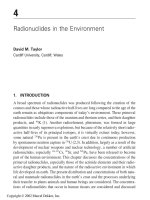Heavy Metals in the Environment - Chapter 18 pps

Heavy Metals in the Environment - Chapter 18 pps
... ethylene glycol ethers, and quantified the risk into no-, low-, medium-, and high-exposure categories. They found elevated risks of SABs for female workers in the medium- and in the high-exposure categories, ... anemia with increased zinc protoporphyrin/heme ratios also confirming biochemical effects on the heme bio- synthetic pathway. In the 2-year exposure study, a significant...
Ngày tải lên: 11/08/2014, 15:20

Heavy Metals in the Environment - Chapter 10 pps
... as a tanning or cross-linking reagent. Al 3ϩ seems capable of cross-linking proteins, and proteins and nucleic acids. In fluids low in citrate, transferrin, and nucleotides, the catecholamines may well ... Gastrointestinal Tract to the Brain Only a small amount of the total ingested Al is absorbed via the gastrointestinal tract, and the majority of that is excreted into the uri...
Ngày tải lên: 11/08/2014, 15:20

Heavy Metals in the Environment - Chapter 15 pps
... hard-metal ATPases, in particular characteristic cyste- ine- or histidine-rich metal-binding motifs at the N-terminus and a Cys-Pro-Cys (orHis)sequenceinthesixthmembrane-spanningsegment(Fig.2).Thepresence of ... CXXC metal-binding sequences in their N-termini and a CPC sequence in a membrane-spanning segment (11). Peptides correspond- ing to the N-terminal metal binding domains have...
Ngày tải lên: 11/08/2014, 15:20

Heavy Metals in the Environment - Chapter 1 pot
... trapped in the intestinal mucosa, not reaching the systemic circula- tion to the same extent as in persons with normal zinc intake and therefore in- creasing susceptibility to copper deficiency. The ... analy- sis of the current state of knowledge of heavy metals in the environment. The volume begins with a chapter on the essentiality and toxicity of metals. Th...
Ngày tải lên: 11/08/2014, 15:20

Heavy Metals in the Environment - Chapter 2 pot
... ions. These two oxidation states are the most common in environmental samples. The redox method using the Fe(II)/Fe(III) system in the presence of 1,10-phenanthroline and diphosphate in a flow-injection ... of the principal analytical methods used in environmental sciences for heavy metals determination. The monitoring of trace metals in the environment has been...
Ngày tải lên: 11/08/2014, 15:20

Heavy Metals in the Environment - Chapter 3 pdf
... vivo. 4.4 Protein-Protein Interactions Heavy metals have been shown to in uence protein-protein interactions. One example is the disruption of the E-cadherin/catenin cell adhesion complex via the displacement ... and intracellular stability of newly synthesized proteins. An interesting new finding is the linkage between heavy metal–induced toxicity and the function of the ub...
Ngày tải lên: 11/08/2014, 15:20

Heavy Metals in the Environment - Chapter 4 pptx
... cis-diaminodichloro-platinum and other platinum complexes have become first-line drugs in the treatment of certain types of can- cer. Studies with radioactive cis-diaminodichloro-platinum indicate ... about 10% of the radionuclide deposits in the liver and a further 10% in the kidney, the remainder being more or less equally distributed in the other tissues (16). No informa...
Ngày tải lên: 11/08/2014, 15:20

Heavy Metals in the Environment - Chapter 5 pptx
... DNA lesions, including single- and double-strand breaks and DNA-protein cross-links (104, 110–116), and thereby induce mutations (117, 118) . Metals that could generate radical species include nickel, ... Some evidence indi- cates that metals can replace zinc in DNA-binding zinc finger proteins (119), which are typically transcription factors that show a high site-specific DNA bind- ing (...
Ngày tải lên: 11/08/2014, 15:20

Heavy Metals in the Environment - Chapter 6 pptx
... optimizing conditions for the remediation of As- contaminated soils using fungi. In addition, there is little information in the litera- ture on the nature of fungi present in As-contaminated ... scorodite in the mine wastes, generated during centuries of silver, zinc, and lead mining (126,127), leach As into the aquifers and cause natural As contamination in the drinkin...
Ngày tải lên: 11/08/2014, 15:20

Heavy Metals in the Environment - Chapter 7 pot
... (17 ,18) . There is convincing experimental work in animals supporting the concept that arsenic has an immunomodulating effect (19,20) and this may explain the effectiveness of arsenic-containing ... toxic levels in their drinking water, probably as a consequence of increased agricultural irrigation. In recent years the toxic potential, both carcinogenic and noncarcino- genic, of...
Ngày tải lên: 11/08/2014, 15:20